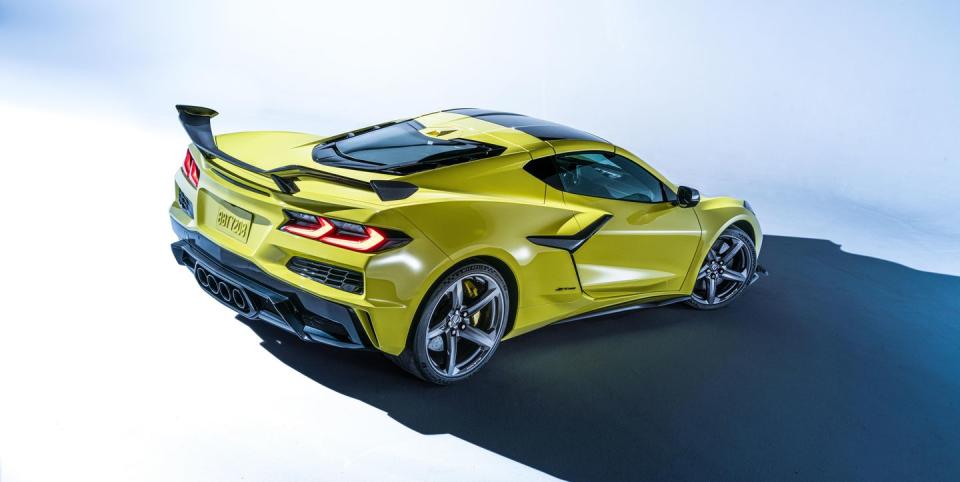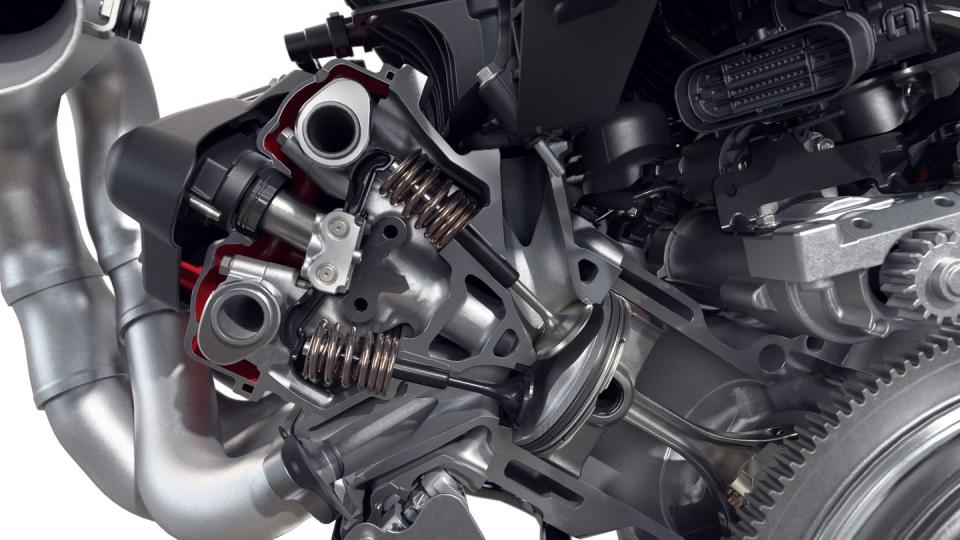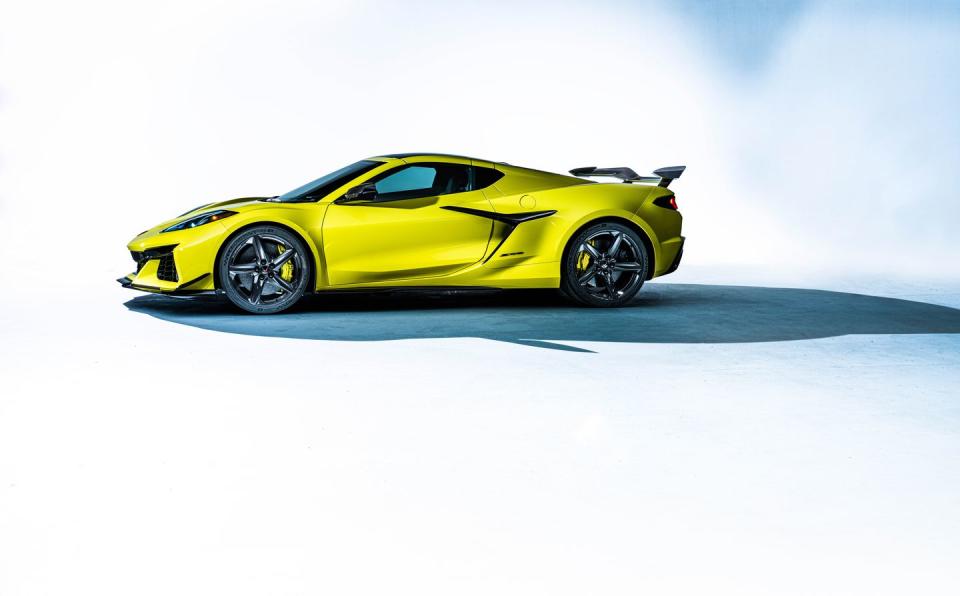2023 Chevy Corvette Z06 Brings 670 HP of Naturally Aspirated Fury

The 2023 Corvette Z06 is officially here with a new flat-plane-crank 5.5-liter V-8 engine.
It makes 670 horsepower and 460 pound-feet of torque and routes through an eight-speed dual-clutch automatic transmission.
Production will start in summer 2022.
Corvette executive chief engineer Tadge Juechter is candid about the real reason why America's sports car got a mid-engine layout: "When we went mid-engine, the justification for it wasn't the standard car." While the mid-engine architecture works great for the 10Best-winning Stingray, the bigger motivation for a new platform with the engine in the middle has everything to do with the 2023 Corvette Z06—a winged wide-body supercar aimed squarely at the enthusiast's heart.
"The higher-horsepower cars benefit the most from getting all of that traction in the back," Juechter continues. And with 670 horsepower, the all-new double-overhead-cam (DOHC) 5.5-liter V-8 is the highest-horsepower naturally aspirated V-8 ever installed in a production car, beating out the 622-hp 6.2-liter fire-breather that powered the 2014 Mercedes-Benz SLS AMG Black Series.

If debuting a naturally aspirated engine in today's turbocharged and electrified world sounds like Recaro suddenly coming out with a saddle, it's likely you haven't heard the Porsche 911 GT3's 4.0-liter flat-six's 9000-rpm call to prayer. On the last Z06 go-round, supercharging upped power, but Chevy heard a lot of feedback suggesting that the Z06 should return to the purity of the high-revving LS7 from the gen-six Corvette. Going naturally aspirated is for drivers who know the difference and crave a certain sound experience and a direct connection that turbos and hybrids can't match. There's no manual; Chevy didn't go that far and is sticking with the eight-speed dual-clutch automatic. While we haven't had a chance to drive the Z06 yet, we've heard the engine. It made the hair on our neck stand on end. If it doesn't do the same to you, may we suggest you reach for Highlights for Children on your next visit to the dentist? —Tony Quiroga
Enter the LT6
Chevrolet insists that the Z06's new LT6 engine is a clean-sheet design—and it is, for the most part. But there is one spec that carries over: the 4.4-inch bore center. This dimension, which defines the distance between the piston centers within a cylinder bank, is common to all Chevy small-block V-8s. Even the last DOHC engine in a Corvette—the C4 ZR1's LT5, with its Lotus-designed head—had 4.4-inch bore centers.
Never mind that LT6 is an engine code shared with a short-lived 4.3-liter V-6 Oldsmobile diesel. The new LT6 is destined for greatness. In a General Motors first, every engine will be put on a dyno, run through a 20-minute break-in, then tested to make sure it's working as advertised before being installed in a new Z06.

The engine is rated at 670 horsepower and 460 pound-feet of torque, with the horsepower peaking at 8400 rpm, right near the 8600-rpm fuel cut. That Ferrari V-8s also make peak power right at redline is no coincidence. In the LT6, more revs mean more power, and the engineering team will use every last rpm it can.
In an automotive world obsessed with electrification and efficiency, it's bold for GM to develop a new engine with a short stroke and a fat bore. Cylinder dimensions are 104.25 millimeters by 80.0, netting a displacement of 5.5 liters. The compression ratio is 12.5:1. And for the engine nerds: The brake mean effective pressure is in excess of 1400 kilopascals.

The C8 team could have easily installed a pushrod V-8 with a blower on top, but a supercharged engine doesn't have the character of a flat-plane-crank V-8. During development, GM traded its Ferrari 458 for the turbocharged 488, and the team agreed with our assessment that some magic was lost. So they bought another 458.
Flat-plane cranks aren't a perfect solution, however. (Owners of Ford's Mustang Shelby GT350, with its high-revving 5.2-liter V-8, will relate.) They shake—a lot. So much that during LT6 development, an oil filter backed itself off on a test stand. Engineers suspected a tech hadn't tightened it, but video evidence uncovered no wrongdoing. The solution was to switch from a screw-on to a cartridge filter.
To keep those forces at bay, titanium connecting rods and intake valves hold reciprocating mass to a minimum. Exhaust valves are filled with sodium. All 32 valves are fitted with two springs each to prevent valve float at high rpm. Direct-acting finger followers have a diamond-like coating and are shimmed during assembly. "Lash for life," says Jordan Lee, GM global chief engineer for small-block engines.

The CNC-machined DOHC heads make the engine bigger than its pushrod siblings. In the C7 engine, height and width had tighter limitations because increasing either wasn't possible without affecting the hood height and footwell width. With the engine behind the cabin, those dimensions are less of a concern. And considering that the C8 was designed around an engine of a specific length, we understand why engineers kept the small-block's bore spacing.
The block has what GM calls a dedicated lower crankcase. It's similar to how Ferrari does dry sumps, with each crank journal residing in a sealed bay. There are six oil scavenge pumps: one in each bay and one in each head.
The intake features two plenums, two 87-mm throttle bodies, three valves that connect the plenums, and eight beautiful trumpets. Those crossover valves tune the intake to optimize both high- and low-rpm operation.

Direct fuel injection is the obvious choice. But instead of injectors squirting fuel on the intake side of the heads near the valley of the vee, the injectors are located between the exhaust valves, a design cribbed from Chevy's Indy V-6. Squirting fuel toward the incoming intake air promotes tumble (the motion and mix of air and fuel). More tumble improves burn.
Flat-plane-crank V-8s are a visceral thing. The intake sound reminds us of the sounds of our youth and draws in our adult selves like a siren song. The first time you hear a C8 Z06 start, your head will snap around like a kid getting called in to dinner on a warm summer night. —K.C. Colwell

Wheels, Wings, and More
No one could possibly accuse the standard C8 of being dull. But the way the engineering team talks about sharpening and "scalpelizing" the Z06 to create the purest-driving Corvette ever makes it sound as if the Stingray were a '70s muscle car.
Their goal: offer a driving experience as urgent as the high-revving engine, which should be approachable but with an incredible depth of capability that a driver can continue to unlock with dedication and skill. Stiffer powertrain mounts transmit more of the engine's vibrations and character to the driver's backside and also enable quicker and crisper shifts from the Tremec eight-speed dual-clutch automatic. For the first time, the Corvette has such stiff spring rates that helper springs are needed to maintain proper check load when the car is at full jounce. Control-arm bushings are also far stiffer, with upper units that are "nearly a spherical bearing," according to vehicle-performance manager Alex MacDonald.

Interestingly, MacDonald says that the Z06 breaks from the recent norm of having track tires that are at their best in the first couple of laps. For the Z06, the Corvette team worked with Michelin to create a new version of its Pilot Sport Cup 2 Rs. MacDonald reports that development drivers are seeing their quickest times 10 laps in.
The 20-inch front and 21-inch rear Z06 wheels are forged aluminum. Carbon-fiber wheels made by Carbon Revolution are an option. In addition to reducing unsprung weight, they are far stiffer, allowing engineers to change the tuning of the steering and magnetorheological dampers for them. That's right—the calibrations are wheel specific, and according to MacDonald, there's a lap-time improvement with the carbon wheels. The Z06 also gets unique front and rear fascias in addition to the typical fender flares that house the 275/30ZR-20 front and 345/25ZR-21 rear tires.

The primary reason for the taller wheels is to fit the Z06's far larger brakes. Standard are iron rotors that are 14.6 inches in front and 15.0 out back, 2.0 and 1.2 inches larger than the Z51 Stingray's, respectively. A Z07 package brings 15.7- and 15.4-inch carbon-ceramic rotors.
Since the C8's mid-engine body works better from an aero perspective, the Z07 package's relatively low wing has both considerably more downforce and lower drag than the giant wing on the last ZR1. It works with a front splitter and canards to aid high-speed stability and cornering, but none of the aerodynamic elements are active.
The many changes to the Z06 have us hungry to actually rip around in it. That opportunity, however, won't come until early next year. —Dave VanderWerp
You Might Also Like

